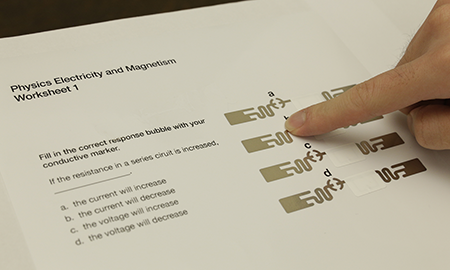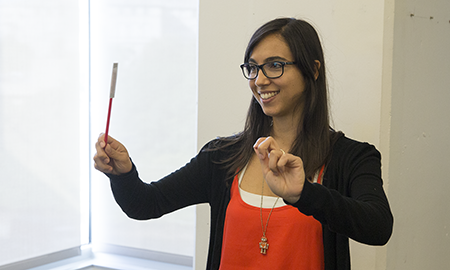 Researchers in the University of Washington’s UbiComp Lab have devised a way to turn a piece of paper into an interactive interface. PaperID—which was developed by UW CSE Ph.D. student Hanchuan Li, EE Ph.D. student Josh Fromm, and CSE and EE professor Shwetak Patel in collaboration with colleagues at Disney Research and Carnegie Mellon University—leverages inexpensive RFID sensors to integrate real-world items into the Internet of Things.
Researchers in the University of Washington’s UbiComp Lab have devised a way to turn a piece of paper into an interactive interface. PaperID—which was developed by UW CSE Ph.D. student Hanchuan Li, EE Ph.D. student Josh Fromm, and CSE and EE professor Shwetak Patel in collaboration with colleagues at Disney Research and Carnegie Mellon University—leverages inexpensive RFID sensors to integrate real-world items into the Internet of Things.
From the UW News release:
“Researchers from the University of Washington, Disney Research and Carnegie Mellon University have created ways to give a piece of paper sensing capabilities that allows it to respond to gesture commands and connect to the digital world. The method relies on small radio frequency (RFID) tags that are stuck on, printed or drawn onto the paper to create interactive, lightweight interfaces that can do anything from controlling music using a paper baton, to live polling in a classroom.
“‘Paper is our inspiration for this technology,’ said lead author Hanchuan Li…’A piece of paper is still by far one of the most ubiquitous mediums. If RFID tags can make interfaces as simple, flexible and cheap as paper, it makes good sense to deploy those tags anywhere.'”
 Each RFID tag has a unique identification that can be picked out by a reader device. With PaperID, a person disrupts the signal between tag and reader by touching, swiping or another interaction. Algorithms capable of recognizing specific movements then interpret the resulting signal interruption as a command, such as switching on a light or selecting the answer to a multiple-choice question. The system can also track a tagged object’s velocity to enable gesture-based sensing and control, like waving a wand in mid-air.
Each RFID tag has a unique identification that can be picked out by a reader device. With PaperID, a person disrupts the signal between tag and reader by touching, swiping or another interaction. Algorithms capable of recognizing specific movements then interpret the resulting signal interruption as a command, such as switching on a light or selecting the answer to a multiple-choice question. The system can also track a tagged object’s velocity to enable gesture-based sensing and control, like waving a wand in mid-air.
“‘These little tags, by applying our signal processing and machine learning algorithms, can be turned into a multi-gesture sensor,’ Li said. ‘Our research is pushing the boundaries of using commodity hardware to do something it wasn’t able to do before.'”
The team—which also includes Eric Brockmeyer, Liz Carter and former UW CSE postdoc and EE Ph.D. alum Alanson Sample of Disney Research, and professor Scott Hudson of CMU—will present PaperID tomorrow at the CHI 2016 conference in San Jose, California.
Read the complete UW News release here, and the research paper here. Watch a video demonstration here.
Photo credits: Eric Brockmeyer/Disney Research

